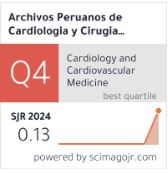Sobrevida al año en pacientes con infarto de miocardio con elevación del segmento ST en el Perú
DOI:
https://doi.org/10.47487/apcyccv.v3i2.218Palabras clave:
Sobrevida, Infarto de Miocardio, PerúResumen
Objetivos. Determinar la sobrevida al año y los factores asociados con la mortalidad en pacientes con infarto de miocardio con elevación del segmento ST en el Perú. Métodos. Se realizó un análisis de la cohorte de pacientes incluidos en el registro PERSTEMI-II durante el año 2020, en quienes se evaluó la sobrevida al año del evento y sus factores de riesgo mediante el análisis de sobrevida de Kaplan-Meier y regresión de Cox. Resultados. De 374 pacientes del estudioPERSTEMI-II, 366 (97.9%) completaron el seguimiento hasta el año del evento con una sobrevida de 85%. La reperfusión exitosa del infarto se relacionó con mejor sobrevida al año (Hazard ratio [HR]=0,30, IC 95%: 0,14-0,62, p=0,001). La edad (HR=1,04, IC 95%: 1,01-1,07, p=0,003); la enfermedad renal crónica (HR=2,15, IC 95%: 1,04-4,39, p=0,037) y el choque cardiogénico (HR=6,67, IC 95%: 3,72-11,97, p<0,001) fueron factores de mayor mortalidad al año de seguimiento. Conclusión. El registro PERSTEMI-II es el primer registro peruano que brinda datos de sobrevida tras un infarto de miocardio con elevación del segmento ST, siendo esta del 85% al año. La reperfusión exitosa mejora la sobrevida al año posinfarto.
Descargas
Referencias
Roth G, Mensah G, Johnson C, Addolarato G, Ammirati E, Baddour L, et al. Global BUrden of Cardiovascular Diseases and Risk Factors, 1990-2019: Update from GBD 2019 study. J Am Coll Cardiol. 2020;76(25):2982-3021. doi: 10.1016/j.jacc.2020.11.010.
Ibanez B, James S, Agewall S, Antunes M, Bucciarelli-Ducci C, Bueno H, et al. 2017 ESC Guidelines for the management of acute myocardial infarction in patients presenting with ST-segment elevation: The Task Force for the management of acute myocardial infarction in patients presenting with ST-segment elevation of the European Society of Cardiology (ESC). Eur Heart J. 2018;39(2):119-177. doi: 10.1093/eurheartj/ehx393.
Chacón-Diaz M, Vega A, Aráoz O, Ríos P, Baltodano R, Villanueva F, et al. Características epidemiológicas del infarto de miocardio con elevación del segmento ST en Perú. Resultados del PEruvian Registry of ST-segment Elevation Myocardial Infarction (PERSTEMI). Arch Cardiol Mex. 2018;88(5):403-12. doi: 10.1016/j.acmx.2017.11.009.
Chacón-Diaz M, Rodríguez Olivares R, Miranda-Noé D, Custodio - Sánchez P, Montesinos Cárdenas A, Yabar Galindo G, et al. Tratamiento del infarto agudo de miocardio en el Perú y su relación con eventos adversos intrahospitalarios: resultados del Segundo Registro Peruano de Infarto de Miocardio con elevación del segmento ST (PERSTEMI-II). Arch Peru Cardiol Cir Cardiovasc. 2021;2(2):86-95. doi: 10.47487/apcyccv.v2i2.132.
Chacón-Díaz M, Hernández-Vásquez A, Vargas-Fernández R, Bendezu-Quispe G. Study protocol of the PEruvian Registry of STsegment Elevation Myocardial Infarction II (PERSTEMI-II) study. PLoS One. 2021;16(9):e0257618. doi: 10.1371/journal.pone.0257618.
Ríos Navarro P, Pariona M, Urquiaga Calderón JA, Méndez Silva FJ. Características clínicas y epidemiológicas del infarto de miocardio agudo en un hospital peruano de referencia. Rev Peru Med Exp Salud Publica. 2020;37(1):74-80. doi: 10.17843/rpmesp.2020.371.4527.
Brodie BR, Stone GW, Cox DA, Stuckey TD, Turco M, Tcheng JE, et al. Impact of treatment delay on outcomes of primary percutaneous coronary intervention for acute myocardial infarction: Analysis from the CADILLAC trial. Am Heart J. 2006;151(6):1231-8. doi: 10.1016/j.ahj.2005.07.016.
Terkelsen CJ, Sørensen JT, Maeng M, Jensen LO, Tilsted H-H, Trautner S, et al. System Delay and Mortality Among Patients with STEMI Treated with Primary Percutaneous Coronary Intervention. JAMA. 2010;304(7):763-71. doi: 10.1001/jama.2010.1139.
McNamara RL, Wang Y, Herrin J, Curtis JP, Bradley EH, Magid DJ, et al. Effect of Door-to-Balloon Time on Mortality in Patients With ST-Segment Elevation Myocardial Infarction. J Am Coll Cardiol. 2006;47(11):2180-6. doi: 10.1016/j.jacc.2005.12.072.
Brodie BR, Hansen C, Stuckey TD, Richter S, Ver Steeg DS, Gupta N, et al. Door-to-Balloon Time with Primary Percutaneous Coronary Intervention for Acute Myocardial Infarction Impacts Late Cardiac Mortality in High-Risk Patients and Patients Presenting Early After the Onset of Symptoms. J Am Coll Cardiol. 2006;47(2):289-95. doi: 10.1016/j.jacc.2005.08.065.
De Luca G, Suryapranata H, Zijlstra F, van ’t Hof AWJ, Hoorntje JCA, Gosselink ATM, et al. Symptom-onset-to-balloon time and mortality in patients with acute myocardial infarction treated by primary angioplasty. J Am Coll Cardiol. 2003;42(6):991-7. doi: 10.1016/s0735-1097(03)00919-7.
Ye Q, Zhang J, Ma L. Predictors of all-cause one-year mortality in myocardial infarction patients. Medicine 2020;99(29):e21288. doi: 10.1097/MD.0000000000021288.
Nauta ST, Deckers JW, Akkerhuis KM, van Domburg R. Short- and long-term mortality after myocardial infarction in patients with and without diabetes: changes from 1985 to 2008. Diabetes Care. 2012;35(10):2043-7. doi: 10.2337/dc11-2462.
Nauta ST, Deckers JW, van der Boon RM, Akkerhuis KM, van Domburg R. Risk factors for coronary heart disease and survival after myocardial infarction. Eur J Prev Cardiol. 2014;21(5):576-83. doi: 10.1177/2047487312460514.
Nauta ST, Deckers JW, van Domburg RT, Akkerhuis KM. Sex-related trends in mortality in hospitalized men and women after myocardial infarction between 1985 and 2008: equal benefit for women and men. Circulation. 2012;126(18):2184-9. doi: 10.1161/CIRCULATIONAHA.112.113811.
Isaksson R-M, Jansson J-H, Lundblad D, Näslund U, Zingmark K, Eliasson M. Better long-term survival in young and middle-aged women than in men after a first myocardial infarction between 1985 and 2006. An analysis of 8630 patients in the northern Sweden MONICA study. BMC Cardiovasc Disord. 2011;11:1. doi: 10.1186/1471-2261-11-1.
Rapsomaniki E, Shah A, Perel P, Denaxas S, George J, Nicholas O, et al. Prognostic models for stable coronary artery disease based on electronic health record cohort of 102 023 patients. Eur Heart J. 2014;35(13):844-52. doi: 10.1093/eurheartj/eht533.
Ferrari R, Fox K. Heart rate reduction in coronary artery disease and heart failure. Nat Rev Cardiol. 2016;13(8):493-501. doi: 10.1038/nrcardio.2016.84.
Pereira-Barretto AC, Bacal F, de Albuquerque DC. Most heart failure patients die from pump failure: implications for therapy. Am J Cardiovasc Drugs. 2015;15(6):387-93. doi: 10.1007/s40256-015-0135-2.
Dagres N, Hindricks G. Risk stratification after myocardial infarction: is left ventricular ejection fraction enough to prevent sudden cardiac death? Eur Heart J. 2013;34(26):1964-71. doi: 10.1093/eurheartj/eht109.
Matic DM, Asanin MR, Vukcevic VD, Mehmedbegovic Z, Marinkovic J, Kocev N, et al. Impact on long-term mortality of access and non-access site bleeding after primary percutaneous coronary intervention. Heart. 2019;105(20):1568-1574. doi: 10.1136/heartjnl-2019-314728.
Pasea L, Chung S-C, Pujades-Rodriguez M, Moayyeri A, Denaxas S, Fox KA, et al. Personalising the decision for prolonged dual antiplatelet therapy: development, validation and potential impact of prognostic models for cardiovascular events and bleeding in myocardial infarction survivors. Eur Heart J. 2017;38(14):1048-1055. doi: 10.1093/eurheartj/ehw683.
Booth GL, Kapral MK, Fung K, Tu JV. Relation between age and cardiovascular disease in men and women with diabetes compared with non-diabetic people: a population-based retrospective cohort study. Lancet. 2006;368(9529):29-36. doi: 10.1016/S0140-6736(06)68967-8.
Bosch X, Theroux P. Left ventricular ejection fraction to predict early mortality in patients with non-ST-segment elevation acute coronary syndromes. Am Heart J. 2005;150(2):215-20. doi: 10.1016/j.ahj.2004.09.027.
Custodio - Sánchez P, Miranda D, Murillo L. Impacto de la pandemia por COVID-19 sobre la atención del infarto de miocardio ST elevado en el Perú. Arch Peru Cardiol Cir Cardiovasc. 2020;1(2):87-94. doi: 10.47487/apcyccv.v1i2.22.

Publicado
Número
Sección
Licencia
Derechos de autor 2022 La revista es titular de la primera publicación, luego el autor dando crédito a la primera publicación.

Esta obra está bajo una licencia internacional Creative Commons Atribución 4.0.

















